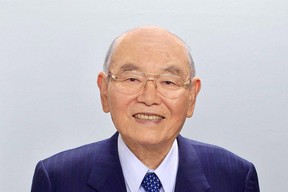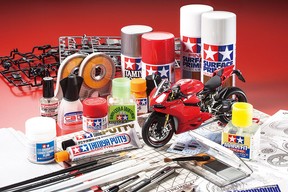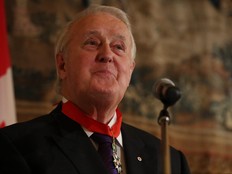How Tamiya pioneered today's ultra-detailed model-car kits
Marking the July passing of Tamiya chair Shunsaku Tamiya by looking at how his passion for accuracy shaped his scale-model company

Article content
There’s a natural progression for most young gearheads, anxious to get their hands on totemic representation of the cars and trucks they covet, but are still too young to legally own. It usually starts out with a simplified wood block with wheels and a vaguely automotive shape, or perhaps a plastic version of the same, safe to drop in the mud or lose in the yard for weeks at a time. Then there’s the level-up to Hot Wheels, 1:64-scale replicas with a more realistic take on the styling cues and brand details that are so enthralling to youngsters (and oldsters alike).
It’s here the path often splits. For some, diecast cars are an end in themselves, a doorway to larger and larger scale models that are increasingly intricate (and considerably more expensive) and destined for the display case or the bedroom shelf. For others, the desire to get more hands-on with their passion leads them to the hobby shop, where an entire universe of build-it-yourself kits awaits.
Offering a level of detail no diecast can match, and promising the chance to either customize or faithfully reproduce what’s sitting in the showroom, plastic model kits have remained at the top of the replica food chain for decades. Of all those companies making kits, one name stands above the pack. Tamiya’s dominance over the model kit world was guided by the loving hand of its chairman, Shunsaku Tamiy, and his death this past July after nearly 40 years at the helm marks the end of modelling’s golden era.
From Wood Chips to Plastic Ships

Yoshio Tamiya, Shunsaku’s father, had been producing commercial vehicles under the Tamiya name prior to the Second World War, but the devastation of that conflict forced him to start all over again following the armistice. The new Tamiya corporation began doing business in 1946, but it wasn’t until 1960 that it traded the lumber business for full-time model kit production. The initial transition period saw it focus almost entirely on wooden kits and toys as a side line to the sawmill. It’s here that Shunsaku first made his mark on the company, making sure the planes and boats they were building were as accurate as possible.
Once model kits became Tamiya’s primary business in the 1950s, the next challenge it faced was dealing with the barrage of plastic kits that were flooding the Japanese market from foreign manufacturers. It’s here that the company made the fateful decision to go all-in on plastic model kits of their own—starting with the battleship Yamato, a fearsome monster sporting the largest guns ever fitted to a sea-going vessel.
Plastic kits were initially much more expensive for Tamiya to build than its traditional wood models, but a technological shift from metal moulds to injection moulding in the 1960s levelled the board and took the reigns off of the imaginative designs at the company. Most importantly, Shunsaku’s focus on detail (he was now playing a larger role at the company) carried over from the wooden-kit days to the plastic revolution, which gave Tamiya a considerable advantage over other manufacturers simply interested in making a quick buck with “good enough” designs.
Just how accurate were Tamiya models of this era? According to the New York Times, a 1967 kit of Honda’s Formula One car, produced from sketches made by the kit-maker’s design team after a walk-around of the vehicle, was so accurate that Honda briefly considered taking legal action, accusing Tamiya of corporate espionage.
Accurate to a Fault
Detail and quality weren’t just Tamiya’s strategy for achieving success at home in Japan—they also proved to be the key to unlocking the lucrative American market. Shunsaku’s devotion to accuracy continued to fuel the company’s expansion, and acceptance, as a global leader in model kits.
He often went to great lengths to ensure the models bearing the Tamiya logo were perfect analogs to their real-world counterparts. Sometimes this meant buying a real Porsche 911 so it could be disassembled and photographed. Other times, it meant reaching out to the Soviet embassy in Tokyo to ask them no-doubt-unwelcome questions about its tanks (Shunsaku was a diehard military vehicle enthusiast since childhood).
Most of the time, however, it meant taking to the air to visit this museum or another, sketchbook or camera in hand, so he could add to the growing reference database that was vital to Tamiya’s operations.
A Legacy of Passion

By the 1980s, Tamiya had branched out into remote-control cars, kits that could be controlled via programmable microprocessors, and even track-based “Mini 4WD” racers, all of which blossomed the company’s fortunes and helped push the technology that could be stuffed into small automotive toys and models into the future. So celebrated is the company in Japan that the streets of its native Shizuoka are lined with life-size representations of the model kits that built its fortune.
Shunsaku became company president in 1984, and maintained a hand in company affairs even in the days leading up to his death at the age of 89. In many ways, his tenure can be regarded as the end of an era not just in the world of modelling, but in business in general. He made sure to keep the company in family hands throughout his lifetime, avoiding the temptation to sell out to larger corporate interests or fall prey to the siren call of private equity that is currently gutting institutions with histories as long and glorious as Tamiya’s.
More than that, however, Shunsaku Tamiya showed that there was place in the business world not just for family, but for passion. Tamiya didn’t become the world’s leading model kit company because of a relentless drive for profit, or the ruthless consolidation of its competitors. It got there on the back of one man’s obsession with getting the details right—no matter how small—and his ability to create a culture that celebrated being the best rather than simply the biggest.
Sign up for our newsletter Blind-Spot Monitor and follow our social channels on X, Tiktok and LinkedIn to stay up to date on the latest automotive news, reviews, car culture, and vehicle shopping advice.



















Postmedia is committed to maintaining a lively but civil forum for discussion. Please keep comments relevant and respectful. Comments may take up to an hour to appear on the site. You will receive an email if there is a reply to your comment, an update to a thread you follow or if a user you follow comments. Visit our Community Guidelines for more information.